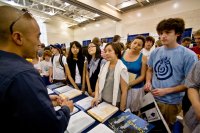Sharing College and Career Options With Families
A middle school and a high school host an informational event for parents and guardians on some of the post-graduation options open to their children.
Your content has been saved!
Go to My Saved Content.“What’s your dream for this year, if anything was possible?” a teacher asked a colleague and me last year.
The colleague was the coordinator of our middle school’s AVID program, a college and career readiness program that I also work on. We agreed that our dream for the year would be to engage more with students’ families so that they would understand how they might better support their child’s future goals. We had one parents’ event to provide insight into what students learn in AVID, and that did not seem like enough.
We decided to create a learning experience for parents and guardians to share some of the college, career, and community opportunities available to their children. Knowing that only 50 percent of our students who graduated from high school were enrolled in some form of post–high school education, we decided to team up with the high school’s AVID coordinator to build an event for parents—and we guided the students to lead it.
The Initial Logistics
Because we envisioned an event for parents and guardians, it needed to be at night when families could attend. We wanted students to participate, but because the high school students in particular were very busy, we opted to manage some of the logistics to get the event organized and then have students take over.
First of all, we cleared it with our principals and district superintendent to have the event encompass our complex (also known as a school district), which has five elementary schools, one middle school, and one high school.
The agenda included an online check-in, a swag bag pickup when families arrived, an opening statement by students, a light dinner in takeout boxes, two breakout sessions, an info fair (held in three locations to accommodate the 600 families that attended), and a raffle. For the three-hour event, we had over 20 breakout room presenters and 19 fair booth participants, including eight college representatives—many breakout room presenters also ran a booth.
One person from our team arranged for donations from community partners: raffle prizes, swag bag items, and food. These community donations made the event feel welcoming and friendly, creating a feeling that the community supported and cared for the schools.
Setting all this up took eight after-school meetings—around 15 hours—and about an hour a week for 10 months spent on tasks related to the event. That’s a lot of time, but it definitely seemed worthwhile.
Handing Off Duties to Students
It was critical that students play a large role in this event. The high school AVID teacher considered their participation to be a way of giving back to a school and community that had given them so many opportunities—college tours and information, guest speakers, scholarships, internships, and part-time jobs.
Students were given a week to work on this event in class, and they spent some of their own time on it as well. A small group of students hosted a panel on the experience of transitioning from high school to college; the rest scripted the program, set up the classrooms for breakout sessions, and explained to teachers why the event was so important. Breakout session presenters included college and trade school representatives, military recruiters, and people from businesses and nonprofit organizations. We had information on topics like how to fill out the FAFSA form and financial planning for college.
Bringing in Community Organizations
Along with having having representatives from two- and four-year colleges, trade schools, businesses, and the military, we were fortunate to have representatives of organizations such as OceanIt, Kupu Hawaii, and Purple Mai‘a—organizations care deeply about Hawai‘i and its place-based values.
When thinking about organizations to invite to an event, it’s important to consider groups that are rooted in your community because they’re the ones that will be most relevant to families. Groups that have worked with your school in the past, have welcomed student interns, or have some ties to your school or community are good candidates.
Feedback From Participants
At the end of the event, we asked the participants to share their feedback. We were happily surprised to see a lot of positive feedback from families, who were appreciative that we put on the event to inform them of their children’s options. One even said that based on the night they were considering a career change.
A key point was that the small-group and breakout-session formats were very much appreciated. Those settings allowed for more questions and immediate answers—the line of communication was more efficient than in the larger groups. We’re hosting a similar event this school year, and we will work to keep the groups small and students deeply involved to create a rich experience for families.
